Since we talk about Forgotten NY in terms of decades now, it’s been a good 14 years since I covered the Gowanus area of Brooklyn in any depth at all. I have to say I’m totally fascinated with the area because an industrial canal that snakes through a NYC neighborhood occurs only once in the five boroughs, like life in the solar system. (There have been others — Canal Street in Manhattan, as well as the much shorter Canal Street in Stapleton, Staten Island, now cover over former canals).
On two separate days — sandwiched by a Forgotten NY tour in the area — I covered the Gowanus Canal area. The first was at dusk, and the second was in midday but in a much longer walk that took me from downtown Brooklyn all the way to Broadway in Bedford-Stuyvesant that featured lengthy swaths of Fulton Street and Stuyvesant Avenue, but I’ll cover that leg of the walk in a separate page. Today, I’ll note Downtown Brooklyn through Gowanus into Park Slope. Bear in mind that there will be variances in lighting because I got these shots at two completely different times of day.
Gowanus bears plenty of relics of its industrial past, but now developers and real estate moguls have gotten into the act, building new apartment buildings on the banks of the noisome and noxious waterway. As we’ll see, though, there’s a boon in that, if only because parts of the canal heretofore barred from the public have been opened up.

Getting off at the Nevins Street station (2, 3, 4, 5 trains) I drifted north to Fulton Street and was immediately accosted by this impressive painted ad for a former J. Michaels furniture store at Hudson Avenue. J. Michaels, “the friend of the people,” was in business over a century before merging with the Muriel Siebert Financial Corp. in 1996. The store had numerous branches in Brooklyn and I’ve found a number of painted ads for it over the years. I hadn’t been by here for awhile and I discovered that the teardown that revealed it occurred in 2014, so this corner has been gathering weeds since.
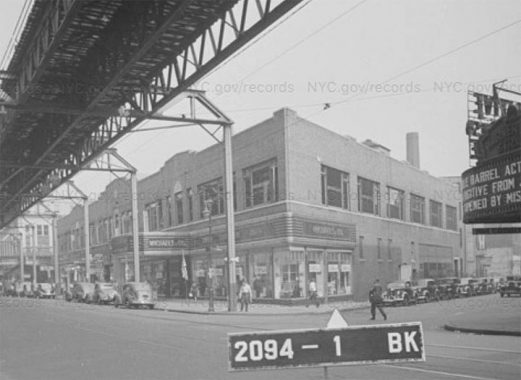
Here’s the J. Michaels store in 1940, photographed from Rockwell Place. Photo from the NYC Municipal Archives. The placard shows the property block and lot numbers. Above we see the Fulton Street Elevated; this section of it was removed in 1942.
Hudson Avenue itself is a bit of a relic. It used to run continuously from Fulton Street north through Vinegar Hill to the East River, but most, except for a few blocks in Vinegar Hill (a Brigadoonish-like bit of small town Brooklyn east of DUMBO) and one block here were obliterated by the BQE and the Farragut Houses in the 1950s.

The facade of the former Strand Theatre at Fulton Street and Rockwell Place was somewhat compromised in 2013 when BRIC (Brooklyn Information and Culture) and art studio Urban Glass constructed large neon signs on the building’s exterior. The adjoining Majestic Theater’s face can still be seen next door; the Majestic is now the Brooklyn Academy of Music’s Harvey Theater. The Majestic is the older of the two, opening in 1905.
The Strand was built as a vaudeville house in 1918 and in its later years, it was a bowling alley and glass factory. In fact till quite recently the bowling alley’s faded ad could be seen on the building exterior on the Rockwell Place side. Urban Glass moved in in 1983; BRIC in 1993. The Strand’s Latin inscriptions “life is short, but art persists” and “seize the day, time flies” are still there, somewhat obscured by the piping.
The Ashland is a new residential tower, with rental apartments, on Fulton between Rockwell and Ashland Places. According to the NY Times, there’s about an even mix of market-rate and “affordable” units. A new food hall called the Gotham Market is on the ground floor; it wasn’t yet open when I passed by. Food halls are increasingly popular; the nearby City Point basement hall has a branch of Katz’s Deli. I like one called Berg’n, which is run my an old boss of mine, Jon Butler; I did pieces for Brownstoner when he owned it.
Rockwell Place is one of those obscure Brooklyn streets no one’s heard of, but it’s in the middle of things, bordering both BRIC and the Brooklyn Academy of Music. It runs two blocks, from DeKalb south to Lafayette, a block west of Ashland Place. Few of its older buildings remain, and that’s a shame because as the Archives shows, some were quite intriguing.

A mishmash of Brooklyn roads come together at what used to be called Temple Square: Flatbush, Lafayette and 3rd Avenues, as well as Schermerhorn Street. The namesake of the square is the imposing 1917 Baptist Temple.
The present Baptist Temple sanctuary has been host to many famous preachers, and contains windows made by Colonial Art Glass of Brooklyn from sketches by Corwyn Knapp Linson. Edward Morris Bowman, a founder of the American Guild of Organists, established the largest volunteer choir in turn-of-the century America, of which Alexandre Guilmant was an honorary member.
On the evening of July 7, 2010, a devastating three-alarm fire caused serious damage to the church interior and organ. NYC American Guild of Organists
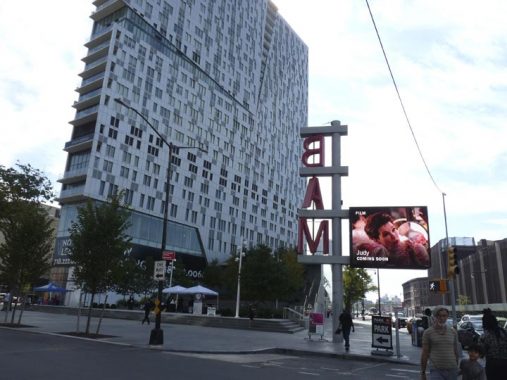
Formerly sleepy and rundown, Flatbush Avenue between Fulton Street and 4th Avenue has seen massive residential construction projects. The Brooklyn Academy of Music has been a mainstay since 1908. I’ve been inside twice, both in the 1980s: for my college commencement in 1981 and also to see Lou Reed and John Cale in Songs for Drella, their tribute to Andy Warhol.
The tower to the rear is 300 Ashland, a razor-thin residential tower that also features “50,000 square feet of city-owned cultural space, with dance studios, theaters and a public library” according to the NY Times.

Meanwhile, another needlenose residential tower has appeared at 333 Schermerhorn, known as The Hub (apparently, the Third Avenue-East 149th Bronx junction called the Hub for decades wasn’t top of mind). When completed in 2015 it was the tallest building in Brooklyn at at height of 611 feet, with 52 floors. It has since been passed by City Point at Albee Square. The Williamsburg Bank Tower at One Hanson with its signature four clock faces, the undisputed title holder from 1928 to well into the 21st Century, has slipped to 9th place and will likely fall out of the top ten!
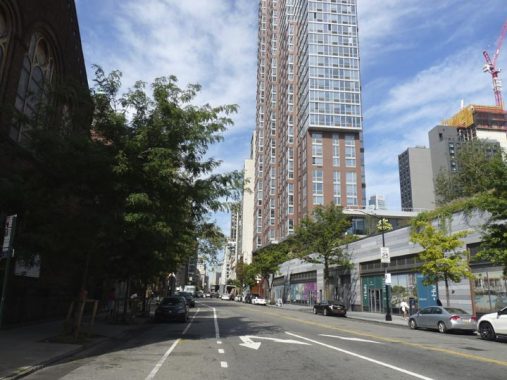
Oddly I’ve never walked Schermerhorn Street, looking for relics. I may be too late since new construction has proceeded apace, especially the Hub. In the colonial era, brothers Peter and Abraham Schermerhorn owned 160 acres of property south of today’s Gowanus neighborhood; after their property was sold in 1835, much of it was developed into Green-Wood Cemetery. A daughter of Abraham’s married into the Astor family, sealing her membership in the “400.”
Schermerhorn is tough to spell and tougher to pronounce; Brooklynites get by with “skimmer-horn.” “Sch” is pronounced “sk” in Dutch, “sh” in German.

Many of downtown Brooklyn’s classic buildings are under the radar and since the areas they’re in aren’t protected by the Landmarks Preservation Commission, they’re endangered. One of these buildings is PS 15 at 3rd Avenue and State Street.
The former PS 15 (these days, the Metropolitan Corporate Academy High School) and the Williamsburg Bank tower thrust competing, ah, fingers at the sky, now refereed by 300 Ashland. This is likely the oldest building on 3rd Avenue (and State Street), having been built in 1840 as the Brooklyn Boys’ Boarding School. It was given a red paint job a couple of decades ago that has long since faded to pink. It’s certainly time someone revitalized this venerable campaigner.
You have to like the way “Public School No. 15” is etched above the second story arched window. It’s as if someone did it with their finger while the concrete was still wet. That might be what happened. A more advanced rendering is chiseled on the Schermerhorn Street side. I have a personal connection with the building as with so many others in downtown Brooklyn. In 1974 I got “working papers” here so I could work while still under 18 years old.
Interestingly the school namechecks 3rd Avenue’s long-ago name. Before about 1880, 3rd Avenue from Flatbush Avenue to about Carroll Street was called Powers Street. It likely was changed to 3rd Avenue because there was another Powers Street in East Williamsburg (Brooklyn annexed the city of Williamsburg in 1855). This is the only remnant of 3rd Avenue’s Powers street days.
Street View has a great shot of old PS 15 and 300 Ashland — two different architectural methods from 1840 and 2020.
Hank’s Saloon, 3rd Avenue and Atlantic, used to be one of Brooklyn’s only dive country and western bars. Well, maybe the only one. Its original location is currently biding its time as a billboard for Marjam, the construction company. The original Hank’s moved to Adams and Fulton Streets in 2017, but that site, too, has closed. We await Hank’s next reincarnation, if any.
Since I never troubled Hank’s (regretfully) I’ll let Wendy Mitchell describe it, from the first edition of New York City’s Best Dive Bars (Ig Publishing, 2003):
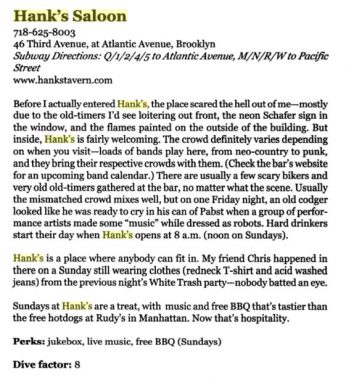
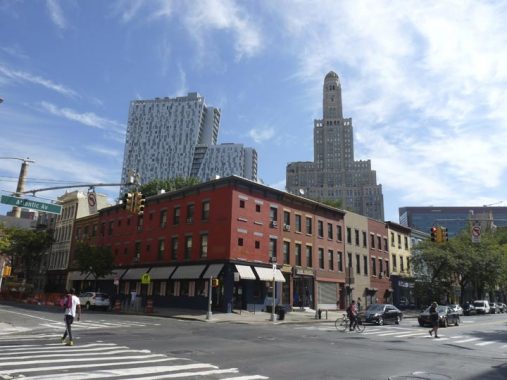
There’s always been a restaurant at the northeast corner of 3rd and Atlantic. For decades, this was Steve’s Diner; in 2019 it’s an outpost of Claw Daddy, a Cajun themed “seafood boil” outfit.
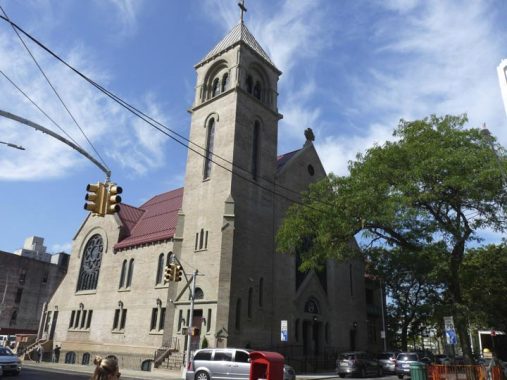
The former Bethlehem Lutheran Church, 3rd Avenue and Pacific St., was constructed in 1894. It’s now known as the Temple of Restoration. The corner mentions Isaiah 28:16:
“…therefore thus says the Lord God, See, I am laying in Zion a foundation stone, a tested stone, a precious cornerstone, a sure foundation: One who trusts will not panic.”
Brownstoner has a couple of photos of the interior.
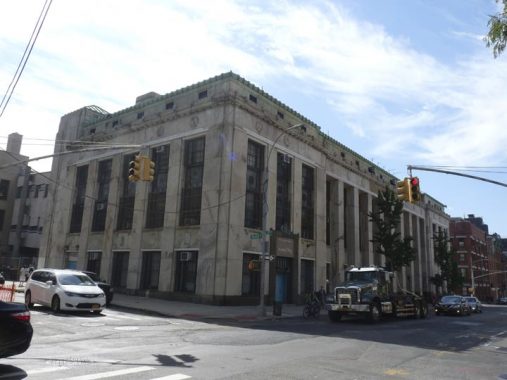
Across 3rd Avenue at Pacific, the sun wasn’t in a great spot for photos of this Deco building formerly owned by the New York Times, which looks like The Fountainhead‘s Howard Roark’s idea of what a printing plant should look like. I was fascinated by the stylized figures of people at work, and the copper clock flanked by a muscleman and nymph.
Brownstoner’s Montrose Morris, a few years ago:
…This building has been repurposed as school space, and is part of a complex housing the Math and Science Exploratory School, Brooklyn High School of the Arts and the Kahlil Gilbran School. The Arts HS is the only NYC public school to offer a program in historic preservation. The NY Times signage is still on the facade of this Classical temple. The large windows at street level along Third Ave allowed the public to watch the printing, collating and folding of the paper as it passed across the floor of the building. This area is now a gymnasium, a sensible reuse of open space. Kahn’s use of Art Deco motifs and styling takes the building to another level, making it one of the most interesting buildings in the Times Plaza area.
As a contrast, check out the former Daily News garage on 3rd between Degraw and Douglass, which I didn’t go by on this walk.
This outpost of the American Society for the Prevention of Cruelty to Animals (ASPCA) is a handsome brick building at 233 Butler, between Nevins and Bond, that went up in 1913; it was once one of the largest treatment centers in the country for disabled and mistreated beasts. Out in front, there’s a horse trough donated by Edith Grinnell Bowdoin; two such others to my knowledge remain, at 5th Avenue and 60th Street at Central Park, and in the traffic island at Northern Boulevard and Linden Place in Flushing. There may be others around town.
The building sold for redevelopment for $9.5M in 2017. A vegan cafe, Public Records, occupies some of the bottom floor.

Across the street is the head of the Gowanus Canal and the main building of the Douglass Street Pumping Station.
I’ll get into the canal’s history in a bit. As far back as the 1880s the Gowanus Canal had become the cloaca of Brooklyn, filled with industrial waste, garbage and sewer outflow. Engineers reached a partial solution by 1911, when a flushing tunnel was dug from the head of the canal at Butler Street southwest to Buttermilk Channel. At the pumping station a steam-powered propeller forced water out of the canal and expelled it into the channel, and cleaner water was admitted into the canal.
Things went, while not literally swimmingly, well enough for a few decades, though the Gowanus Canal would never remind anyone of Venice. The Buttermilk Channel (named because currents would cause milk to change to butter on boats moored there, supposedly) was not the place to deposit raw sewage, which would still find its way into the canal. The flushing tunnel stopped working altogether in the 1960s and it would be fully three decades before it would be repaired; Gowanus Canal became just as foul as before. Typhoid and cholera germs were found in it, prompting the construction of a Red Hook waste water treatment plant eventually constructed in the Brooklyn Navy Yard.
At last, though, the flush pump was repaired in May 1999–after 2000 tons of contaminated mud was dredged from the canal — and the Gowanus is [slowly] on the way to cleanliness and wildlife has returned to its waters.
There are interesting buildings and remnants of a similar age nearby. At Butler and Nevins is the 1913 Gowanus Water Supply Distribution Station, identified in terra cotta on the pediment. The building is currently endangered as the DEP wants the space for a combined sewage overflow tank.

Directly across Butler Street is the stolid, concrete building built in 1914, once home to the printing plant for R.G. Dun and Company. In 2014 plans were announced for a 162-room hotel here. That’s right, half a block away from the Gowanus Canal pumping station and across the street from a proposed sewage tank. Deep Brooklyn! So far, nothing has been done with the site.
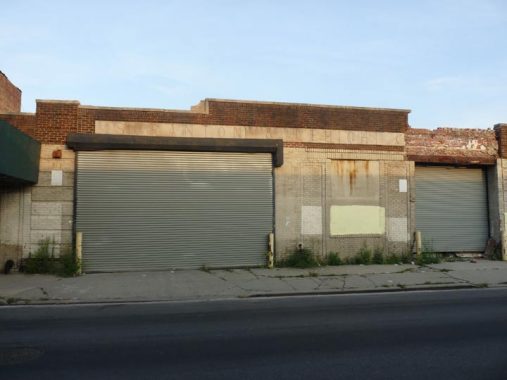
Walking south on Nevins, here’s an unremarkable building but its original purpose can be made out in chiseled lettering above the doorway. It’s a former garage serving delivery vehicles of the Scranton and Lehigh Coal Company, once the largest coal producer in Pennsyvlania. It’s a relic from the days when most NYC buildings were heated with coal. When you’re walking in older neighborhoods, note round metal covers in the sidewalk. Those are coal chute doors that allowed deliverers to chute the coal directly into basement boilers.
The T(heodore) E. Conklin Brass and Copper Company was founded in Manhattan in 1860 and has had a warehouse on the Gowanus Canal since 1959. The building abuts the canal and, the gate to the parking lot, open during the week, allowed me to get in closer to get these photos. The Indispensable Walter Grutchfield reports that the company moved to Hudson Street in 1981, but I suspect there’s still some operations here. A handy Conklin fraction-decimal conversion chart was available on ebay in October 2019.
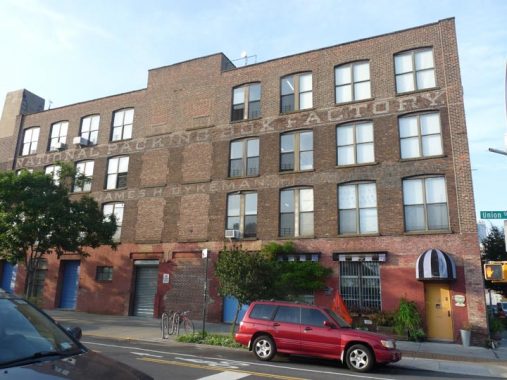
James H. Dykeman’s box factory occupied this building on Union and Nevins. Dykeman “was a carpenter by trade who established himself in the box business in 1877,” according to The Disston Crucible, a Magazine for millmen. “Two large buildings occupy the whole block at Union, Nevins, and Sackett Streets, the fourth side of the property facing the canal, making it possible to bring lumber to the mill.”
Cabinet Magazine, an art/culture quarterly, has offices in the box factory, as well as an exhibit space. Its banner, designed like a classic heraldry shield, features a fox and a hedgehog. The publication explains that the fox knows many small things, but the hedgehog knows only one big thing. Me, I know about lampposts.
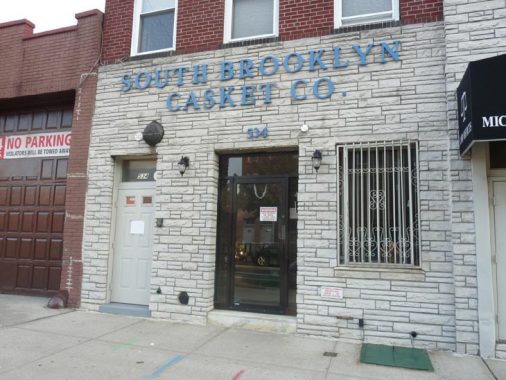
On Union Street between 3rd and Nevins there’s a sort of subgenre of the funerary industry. We will all spend an awfully long time in caskets, and they have to come from somewhere — I’m glad Brooklyn has casket manufacturers (I once saw a faded painted ad for another one on Rockwell Place, but that one had long vanished). Awhile ago during one of my interregnums between jobs — they come frequently — I think this was 2000 — I scored a temp job typesetting those glossy prayer cards that you get at wakes. I didn’t find it fulfilling and left after a short time. That was on Union Street by the canal, too.
The Brooklyn Casket Company, which has a number of buildings on Union Street, was founded in 1931 by Thomas Pontone and was more recently acquired by the larger Milso Industries, which is the name on the trucks you see carrying the coffins out of the low brick buildings in Gowanus and to their customers.

2 Toms Restaurant, 3rd Avenue just off Union, has been a Gowanus mainstay since 1948, a whopping 71 years. Traveling down 3rd Avenue on the B37 bus as a kid, I would note this very same sign going by. However, owner Anthony Catapano, who has managed the place for fifty years has decided to retire and the restaurant will retire along with him at the end of 2019.
It’s an end of an era. Though old-school red sauce spots continue to thrive throughout Brooklyn, Two Toms is among the last of its kind in post-industrial Gowanus. It is small, wood-paneled, and tableclothed. It is only open four days a week, and the menu rarely changes. Catapano does the prepping, cooking, serving — and reservation booking. [Eater]
Two Toms, a Red-Sauce Gem Off the Gowanus Canal [Eater]

Few Brooklyn neighborhoods have their own theme souvenir shops, but Gowanus can make that claim. The Gowanus Souvenir Shop, founded by Ute Zimmermann and Joel Beck in 2016, actually sells Gowanus Canal-themed souvenir items such as T shirts, iron-on patches, jigsaw puzzles, and books. It also hosts walking tours and serves as a community events space.
The Union Street Bridge is one of five spans over the mighty Gowanus Canal. It is the northernmost of the five traffic bridges that cross Gowanus Canal. The bascule bridge was opened March 4, 1905, is 109 feet long and 35 feet wide. Bascules are drawbridges that have leaves weighted heavily on one side in order to balance and lift the bridge when raised. Unfortunately I don’t have any good photos of the bridge itself in summer 2019, as it’s under repair.
All five Gowanus Canal bridges were, until 2005, in the charge of operator Lenny “Chicken Man” Thomas. A cook in his spare time, Thomas studied at the French Culinary Institute and in 1998 collected over 100 of his chicken recipes into a book.
The Gowanus Canal
The canal is quite old: it was begun in 1849, other accounts say 1855 (finished in the 1860s) by narrowing its predecessor, the Gowanus Creek, into a one and a half mile long commercial waterway to provide commercial access to Gowanus Bay. Developer Edwin Litchfield formed the Brooklyn Improvement Company for the express purpose of dredging the Gowanus Creek, then a fresh stream, and making it navigable. With the creation of the new waterway, barges brought in sandstone from New Jersey that was used to build the beautiful brownstones that today still line the streets of surrounding Boerum Hill and park Slope.
The surrounding area’s raw sewage would be pumped directly into the canal, and the new gasworks, coal yards and soap factories along the canal’s length also dropped tons of pollutants directly into it as the years went by. As early as the 1880s the canal was foul and miasmic and its color had changed to a dark Pepto-Bismol shade, prompting locals to call it “Lavender Lake.”
As mentioned above, in the 2000s, the flush pump (which was first built in the 1910s) was repaired and the Canal began to become somewhat cleaner and clearer, with some wildlife returning to it, but by 2011 the pump was broken again and the Canal had reverted to its foetid state. The pump has been going off and on since then, but the canal is now a Superfund site, so eventually, it will be returned to a clean state, though that may take decades.
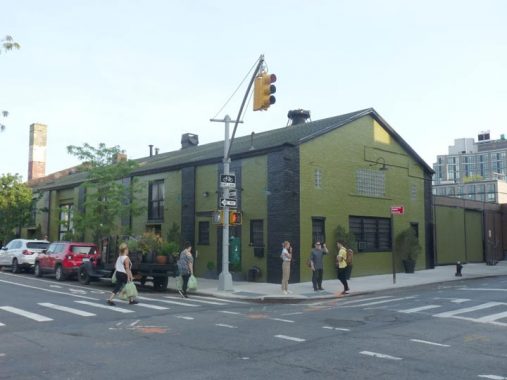
At Bond Street and Union is a lengthy, two story slope-roofed building painted green, and the small sign on the door simply calls it “The Green Building.” it was built in 1889 (though accounts vary: some say as late as the 1930s! That’s quite a swing) and was a brass foundry until 1987. Its present occupant is as an event space for commercial shoots, films, dance and theater performances, and corporate events. The interior features original brick walls, soaring exposed beam ceilings.
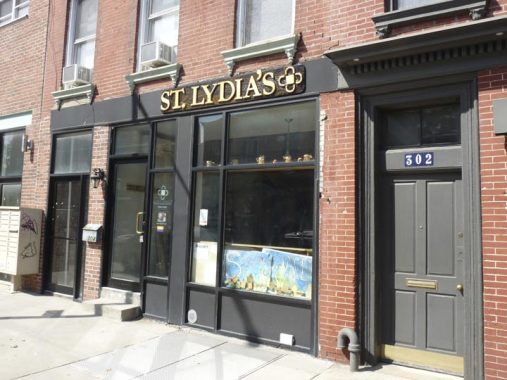
Known as “the hipster church,” St. Lydia’s, the 1,000-square-foot congregation at 304 Bond Street is a co-working space for freelancers by day. The regular Sunday and Monday night services, Christian but nondenominational, are staged as dinner parties. There is an actual Catholic Saint Lydia: she was a dyemaker and as mentioned in Acts of the Apostles, St. Paul’s first convert at Philippi.
I was also attracted to its woodcut sidewalk sign in the Garamond type font.
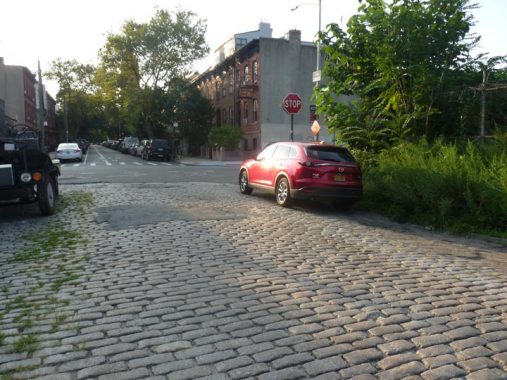
The dead end section of Sackett (we’ve already mentioned caskets — switch the consonants and you’ve got Sacketts) is notable for its still visible Belgian block pavement and curved mast lightpost. In the distance you can see Gowanus’ cathedral-size Catholic church, St. Agnes. Cobble Hiller Katia Kelly was inside a few years ago. I liked the way it appeared in the dusk light of August.
The street is named for Samuel Sackett (1754-1822) whose large residence served as Brooklyn’s first hospital. His son Clarence helped Brooklyn attain its first charter.
The dead ends east of Bond Street let one get “up close and personal” with the Gowanus Canal due to breaks in chain link fences. Don’t fall in, though, you won’t emerge completely intact. Here’s some Sackett Street views.
The Gowanus Canal seen from DeGraw Street. East of 5th Avenue, DeGraw Street’s name was changed to Lincoln Place — honoring the assassinated 16th President — because of a murder!
The outwash from Gowanus Canal’s flush pump can be seen from the dead end of Douglass Street, which has also retained its Belgian block pavement.
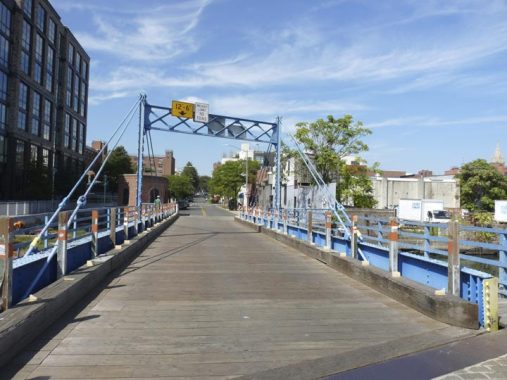
The Carroll Street Bridge
There are only 4 retractile bridges left in the country and NYC has two of them (the other is the Borden Avenue Bridge in Long Island City). Retractile bridges are connected by wires to rollers set perpendicularly to the span; when the bridge opens it rolls on wheels set on steel railings, somewhat like a trolley.
The Carroll Street Bridge over the rushing Gowanus Canal preserves a couple of archaisms. The sign is a clever DOT reproduction of a sign that appeared when the bridge was first opened in 1889; it referred to the “drivers” of horses. The bridge is 165 feet in length and is about 35 feet wide.
I never tire of walking on, and photographing, this amazing artifact.
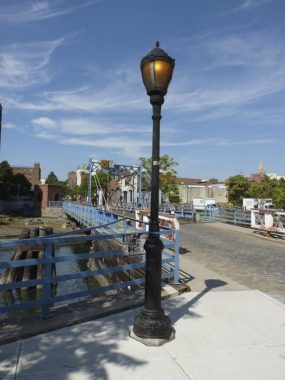
There’s also a “cage” style Type B park lamppost, with the luminaire protected by metal mesh, on the Nevins Street side. When I was a kid, this was the way all park lamps appeared.
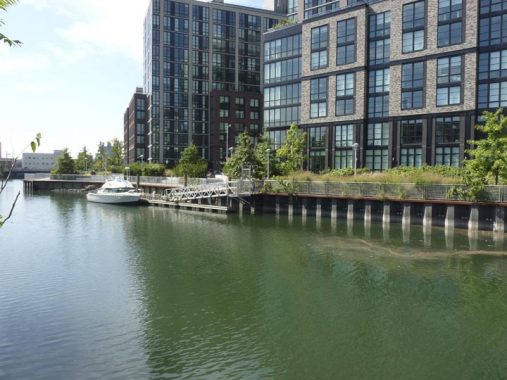
When it comes to gentrification, there’s plenty to complain about. Building luxury and upscale dwellings in struggling neighborhoods tends to bring about the abandonment of lower and middle classes from those neighborhoods — and the businesses that serve them. The opening of the High Line through Chelsea is emblematic of the point.
However, ‘upscaling’ neighborhoods do have the side benefits of improved public spaces. It doesn’t cost me a penny, for example, to visit the new Gowanus Waterfront Park along the west side of the canal between Carroll and 2nd Streets. It was constructed along with the new residential buildings along Bond street that it abuts. This particular view of the Carroll Street Bridge was never before available to the public, except for some intrepid urban explorers. The Gowanus Dredgers Canoe Club is located on 2nd Street at the park’s edge.
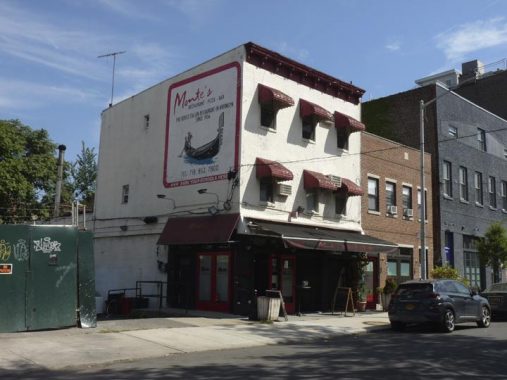
Speaking of venerable Italian restaurants, here’s one that closed and reopened once again, Monte’s, on 451 Carroll Street between Nevins and 3rd Avenue. It opened in 1906 as Angelo’s, became Monte’s Venetian Room in the 1930s, closed in 2008 and reopened in 2011 with a revamped, somewhat healthier menu.
At night, the clientele came from near and far. Sal mentioned politicians, ballplayers Joe Torre and Joe Pepitone, priests from Our Lady of Peace, doctors from Methodist Hospital, fruit merchants from Court Street, comedian Pat Walker and billionaire hotel magnate Leona Helmsley, who brought her dog along with her. Rose mentioned James Caan, Danny Aiello and golden-era Hollywood actress Hedy Lamarr. There was a night in the 70s, recalled by the New York Post, when Sammy Davis Jr. showed up and performed a spontaneous concert into the morning hours. [Carroll Gardens Patch]
Frank Sinatra was a patron, as were the Gallo brothers of Mafia infamy.
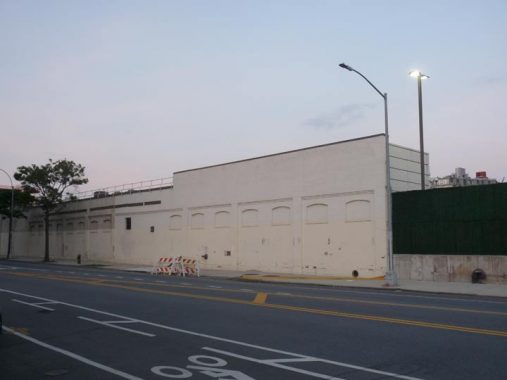
The wall you see here on 3rd Avenue east of 3rd Street is the very same wall that baseballs hit by a major-league Brooklyn franchise, and their opponents, went over. This is not Ebbets Field, but the site of Washington Park, where the Brooklyn Superbas, later known as the Trolley Dodgers and then as the Dodgers, played between 1898 and 1912. The property is owned by Con Edison on Third Avenue, Brooklyn.
The entrance, long since vanished, was at Fourth Avenue and Third Street. In that era, the Dodgers used the nearby Old Gowanus Stone House, built in the late 1600s, as a clubhouse.
After the Dodgers vacated Washington Park in 1912 for the new Ebbets Field in 1913, the Brooklyn Tip Tops of the new Federal League played here for a couple of years until the Federal League folded. The grandstand and field of Washington Park were demolished in 1926. The back of the grandstand is what you see here.
Con Edison quickly snapped up the site and retained the 20-foot high left field wall. This is the oldest section of any former major league ballpark still standing in the country.

After its 1885 construction the original tenant of this gorgeous brick building at 3rd and 3rd was the Somers Bros. Decorated Tinware Company, but American Can was occupying it by the 1920s. The 5th Street Basin of the Gowanus Canal is situated in the back of the building and it’s likely that both companies utilized the canal to ship and bring in materials.
The building is currently occupied by small businesses but its most intriguing use in recent years has happened on its roof, where the Rooftop Films series used it as a venue for the past few years. Of special note are the diamond-shaped windows on the top floor of the 3rd Avenue side.
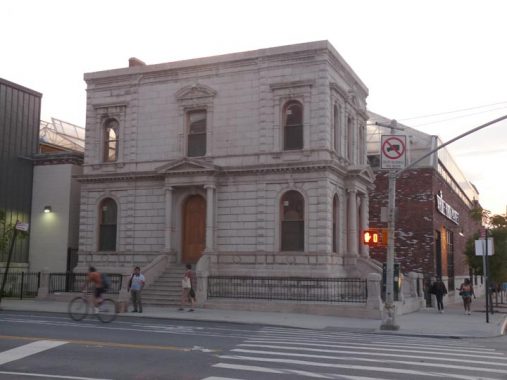
This Beaux-Arts building on the SW corner of 3rd and 3rd, in a corner of the fairly new Whole foods complex, housed the offices of the Brooklyn Improvement Company, founded by Edwin Litchfield for the express purpose of dredging the Gowanus Creek, then a fresh stream, and making it vessel-worthy.
It was built in 1882 by the NY & LI Coignet Stone Company and leased to Litchfield, the Brooklyn Improvement office was incorporated into a new Whole Foods site but is now available for lease. It was in ruins for many years, but oddly, the top to bottom renovation it received is unsatisfactory compared to what it looked like in its classic era.

The sun has set over the Gowanus Canal and on this page. Kudos to Walter Grutchfield, Nathan Kensinger and Montrose Morris, whose research assisted me with the page.
Check out the ForgottenBook, take a look at the gift shop, and as always, “comment…as you see fit.”
10/27/19

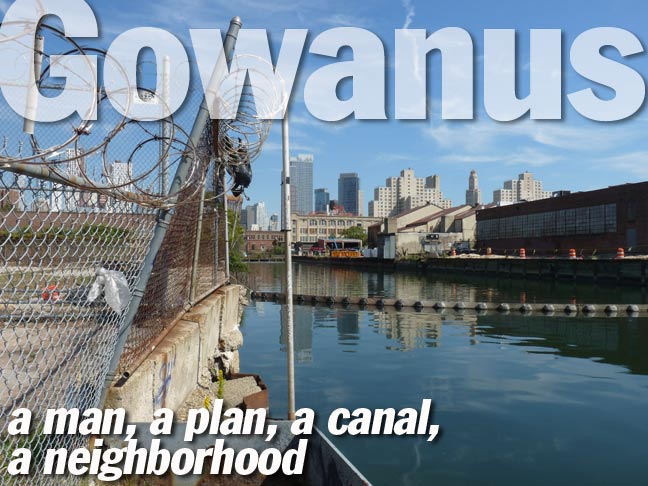
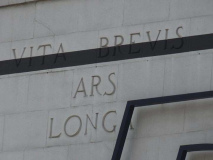
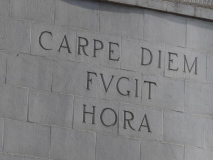
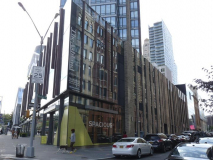
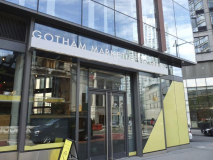
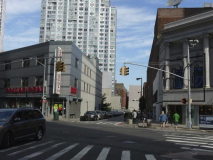
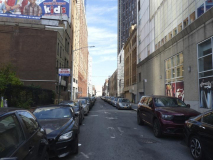
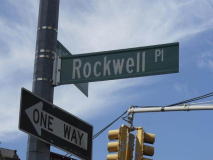
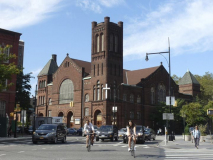
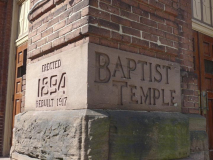

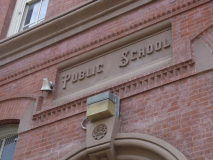
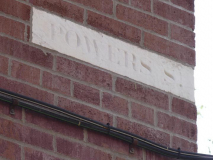
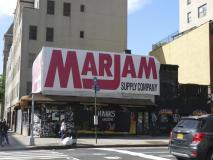
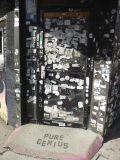
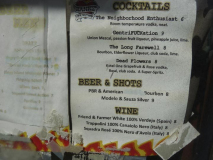

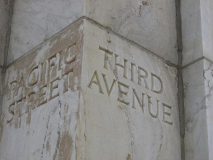
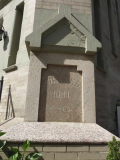
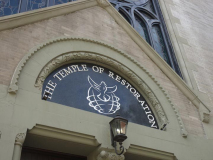
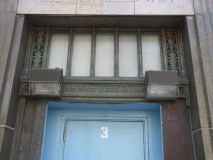
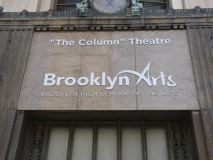
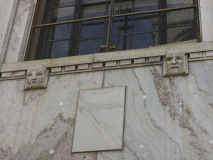
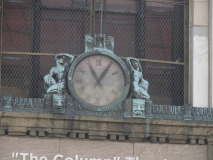

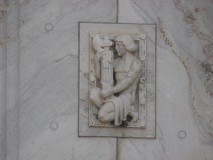

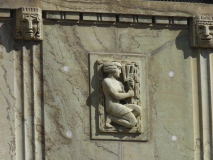


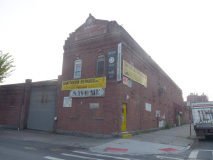
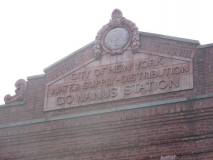
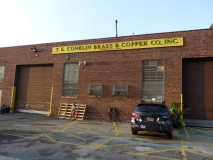

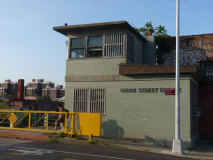
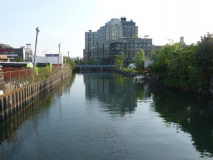
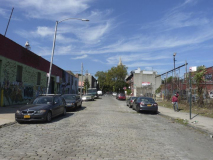

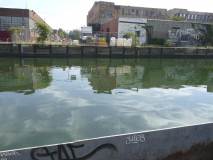
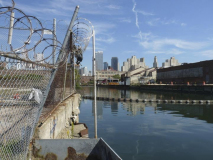
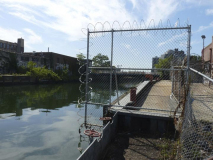

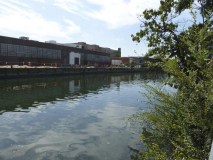
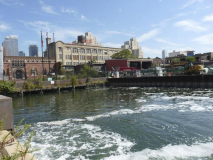

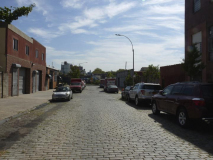

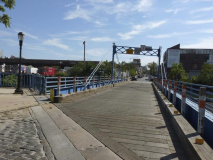
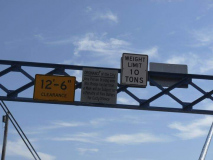
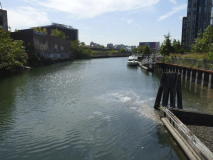
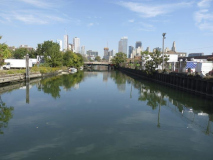
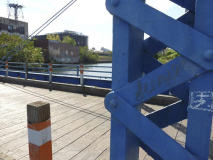
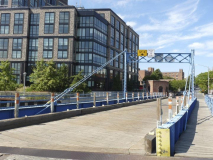
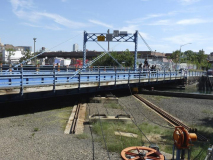
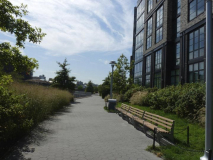
12 comments
Hi, very nice write up! One correction and one addition
1. the old ball park that was along 3rd Avenue was for the Federal League’s Brooklyn Tip Top franchise of 1914-15. The NL Brooklyn team’s Washington Park was a wooden structure, and the Ward brothers, owner of Tip Top Bread, replace the wooden parkt with one of concrete & steel. This ballpark was closer to 4th Avenue, so the area by 3rd was far from where the players were. There is an excellent aerial view of the park at nyc.gov’s 1924 map, and it shows the remaining wall is far from where the field was.
2. On the east side of the Gowanus Canal where 1st Street would be is an old 5 story red brick building. Long before the squatters were chased out, this a power plant the Brooklyn Rapid Transit street trolley system, and before it was filled in, at 1st Street was a finger of the canal for deliveries of coal, and I suppose the departure of ash. Sometime in the decades post-WW2 this finger was filled in with who knows what, but on that same nyc.gov map of 1924 you can see the piles of coal, smokestacks, and barges tied up by the power plant.
Kevin, I hate to say it, but your information is woefully out of date: the “only four” comment was made false in 2003 when the lesser known yet more important of the two Summer St. bridges in Boston was replaced with a new bridge. The other, more widely known Summer St. Bridge still remains, so there’s still three bridges of that design left open but Boston’s bridge hasn’t moved in decades and can’t move again due to its sister bridge being replaced by a regular, non-movable bridge.
And to be blunt: the two NYC bridges aren’t the only retractable bridges left in use as there are retractable bridges in Washington, Michigan, North Carolina, two in the same county in Illinois along the same canal, and one in Louisiana. All of the others retract back back instead of diagonally but they still retract the same way- pulleys and cables along rails. The two in New York aren’t unique, they are just simply the oldest and 3rd oldest bridges.
Hudson Avenue was originally Jackson Street, named for John Jackson, through whose land the street was laid out. Renamed circa November 22, 1847.
Powers Street was named for George Powers, through whose land the street was laid out. Renamed (for continuity with Third Avenue and to eliminate duplication with Powers Street, Williamsburg) on November 29, 1869, effective December 13, 1869.
Rockwell Place was named for William Rockwell, Kings County District Attorney, 1833-39. Originally the portion of Navy Street between DeKalb and Lafayette Avenues. Renamed by on December 23, 1889, effective January 1, 1890.
An assassination scene from the 1991 movie ‘Men of Respect’ were filmed in Monte’s, some of which are seen in this clip https://www.youtube.com/watch?v=sQOq53-CaX8
The Gowanus Canal is featured prominently in “Shamus” (starring Burt Reynolds in the title role. It was filmed on location in Brooklyn in 1973 & therefore it was pregentrification:
https://www.bing.com/images/search?view=detailV2&ccid=mhgCEz76&id=BFDE579B8564D1C6D78693FFAE6CBCF872F5DA17&thid=OIP.mhgCEz76JWaIYydqS6C91QHaD8&mediaurl=https%3a%2f%2f4.bp.blogspot.com%2f-rPxrwFgD_ck%2fVZS4QGf2loI%2fAAAAAAAASDM%2fLRSsuwPWPPQ%2fs1600%2fshamus%252B5%252B%2525282%252529.jpg&exph=728&expw=1366&q=shamus+movie+1973%2fgowanus+canal&simid=608019715892318123&selectedIndex=0&ajaxhist=0
The Gowanus and Newtown Creeks are considered toxic and cannot be dredged. The EPA fear is that the contaminated mud will disperse into the water column.
The Carroll Street Bridge was also featured in a memorable scene in “Heaven Help Us,” the best ever and funniest film depiction of Catholic high school life. The scene featured Kevin Dillon as a bully with a heart of gold, his dad’s car, and bridge tender Larry “Bud” Melman. St. Michael’s in Sunset Park played the role of the school and church.
I always loved how the “G” is covered & an exclamation point is added after the “W” & “S” on the expressway signage annually on the last Sunday in June.
Great article. I started at the old St. Francis College “campus” (perhaps hyperbole) on Butler Street off Court in 1961. My Lebanese grandmother had her own name for the Canal which I won’t presume to replicate in Arabic but translated to “Smelly River”, as accurate a description as I can think of. Haven’t been back to Brooklyn in many years and I wonder how much of the downtown I’d recognize!
I lived in the Gowanus Projects! In fact, I opened up the joint back in 1949! I was a good girl and didn’t venture outside a certain boundary! Your documentary of the surrounding areas is very informative! I thank you because it took me down memory lane and was nostalgic! It also took me into areas I wasn’t allowed…or didn’t allow myself! I nearly jumped when you described P.S 15! That was where I got my first working papers! I left Gowanus in 1964. I only saw Fulton street shopping center this year, 2020. I was disappointed! It’s not the same without Mays D/S, Martin’s A& S and all the other stores. I won’t be returning.
I was a frequent visitor to my mother’s family on Sackett just off Nevis and spent quite a bit of time watching the Conklin Brass crane lift stuff from barges. Any photos?
I am so frustrated that I cannot find a photo of the apartment building we lived in.. It was torn down to build t the Guanus on third avenue. The apartment building was on 3rd avenue that extended
from 56th Street to 57th Street. Can anyone help me.